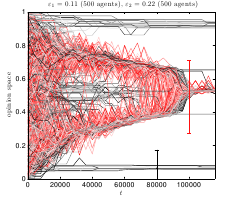Heterogeneous bounds of confidence: Meet, discuss and find consensus!
Jan Lorenz
Inter Science Complexity (2010)
Abstract
Models of continuous opinion dynamics under bounded confidence show a sharp transition between a consensus and a polarization phase at a critical global bound of confidence. In this paper, heterogeneous bounds of confidence are studied. The surprising result is that a society of agents with two different bounds of confidence (open-minded and closed-minded agents) can find consensus even when both bounds of confidence are significantly below the critical bound of confidence of a homogeneous society. The phenomenon is shown by examples of agent-based simulation and by numerical computation of the time evolution of the agents density. The result holds for the bounded confidence model of Deffuant, Weisbuch and others (Weisbuch, G. et al; Meet, discuss, and segregate!, Complexity, 2002, 7, 55-- 63), as well as for the model of Hegselmann and Krause (Hegselmann, R., Krause, U.; Opinion Dynamics and Bounded Confidence, Models, Analysis and Simulation, Journal of Artificial Societies and Social Simulation, 2002, 5, 2). Thus, given an average level of confidence, diversity of bounds of confidence enhances the chances for consensus. The drawback of this enhancement is that opinion dynamics becomes suspect to severe drifts of clusters, where open-minded agents can pull closed-minded agents towards another cluster of closed-minded agents. A final consensus might thus not lie in the center of the opinion interval as it happens for uniform initial opinion distributions under homogeneous bounds of confidence. It can be located at extremal locations. This is demonstrated by example. This also show that the extension to heterogeneous bounds of confidence enriches the complexity of the dynamics tremendously.

